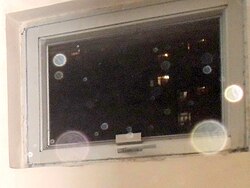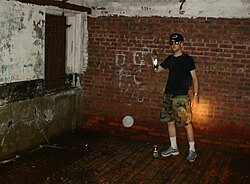Backscatter (photography)

In photography, backscatter (also called near-camera reflection[1]) is an optical phenomenon resulting in typically circular artifacts on an image, due to the camera's flash being reflected from unfocused motes of dust, water droplets, or other particles in the air or water. It is especially common with modern compact and ultra-compact digital cameras.[2][3]

Caused by the backscatter of light by unfocused particles, these artifacts are also sometimes called orbs, referring to a common paranormal claim. Some appear with trails, suggesting motion.[4]
Cause[edit]

Backscatter commonly occurs in low-light scenes when the camera's flash is used. Cases include nighttime and underwater photography, when a bright light source and reflective unfocused particles are near the camera.[1] Light appears much brighter very near the source due to the inverse-square law, which says light intensity is inversely proportional to the square of the distance from the source.[5]
The artifact can result from the backscatter or retroreflection of the light from airborne solid particles, such as dust or pollen, or liquid droplets, especially rain or mist. They can also be caused by foreign material within the camera lens.[2][4] The image artifacts usually appear as either white or semi-transparent circles, though may also occur with whole or partial color spectra, purple fringing or other chromatic aberration. With rain droplets, an image may capture light passing through the droplet creating a small rainbow effect.[6]
Fujifilm describes the artifacts as a common photographic problem:
There is always a certain amount of dust floating around in the air. You may have noticed this at the movies when you look up at the light coming from the movie projector and notice the bright sparks floating around in the beam. In the same way, there are always dust particles floating around nearby when you take pictures with your camera. When you use the flash, the light from the flash reflects off the dust particles and is sometimes captured in your shot. Of course, dust particles very close to the camera are blurred since they are not in focus, but because they reflect the light more strongly than the more distant main subject of the shot, that reflected light can sometimes be captured by the camera and recorded on the resulting image as round white spots. So these dots are the blurred images of dust particles.[2]

In underwater scenes, particles such as sand or planktonic marine life near the lens, invisible to the diver, reflect light from the flash causing the orb artifact in the image. A strobe flash, which distances the flash from the lens, eliminates the artifacts.[7] The effect is also seen on infrared video cameras, where superbright infrared LEDs illuminate microscopic particles very close to the lens. The artifacts are especially common with compact or ultra-compact cameras, where the short distance between the lens and the built-in flash decreases the angle of light reflection toward the lens, directly illuminating the aspect of the particles facing the lens and increasing the camera's ability to capture the light reflected from normally subvisible particles.[2]
Paranormal claims[edit]

Some ghost hunters have claimed that orb shaped visual artifacts appearing in photographs are spirits of the dead.[8][9] Others[who?] have claimed that orbs are an unknown sort of being, based partly on perceived intent in the orbs' movements. Such perceptions have been interpreted by Michael Shermer as examples of agenticity.[10] Prominent paranormal investigators such as Joe Nickell have agreed with skeptic-debunkers' assessments that orbs result from natural phenomena like insects, dust, pollen, or water droplets.[11][12]
See also[edit]
- Bokeh
- Digital artifact
- Entoptic phenomenon
- Lens flare
- Rod (optical phenomenon)
- Rolling shutter
- Will-o'-the-wisp
References[edit]
- ^ a b Robinson, Edward M. (2016). Crime Scene Photography. Academic Press. p. 558. ISBN 978-0-12-802768-4.
- ^ a b c d "Flash reflections from floating dust particles". Fujifilm. Archived from the original on July 27, 2005. Retrieved 2017-06-19.
- ^ Baron, Cynthia (2008). Adobe Photoshop Forensics: Sleuths, Truths, and Fauxtography. Cengage Learning. p. 310. ISBN 978-1-59863-643-7.
- ^ a b Grimm, Tom; Grimm, Michelle (1997). The Basic Book of Photography. Plume (original from Pennsylvania State University). p. 509. ISBN 978-0452278257. Retrieved 2017-06-19.
An additional problem called backscatter occurs when flash light striking these suspended particles reflects back to the camera lens and records on the film as fuzzy white spots. Of course, backscatter can also be reduced by getting the camera as close to your subjects as possible, because the shorter that distance, the fewer the number of floating particles in front of the lens.
- ^ Richard Ferncase. Basic Lighting Worktext for Film and Video. CRC Press; 1992. ISBN 978-1-136-04418-2. p. 66.
- ^ J. David Pye. Polarised Light in Science and Nature. CRC Press; 2015. ISBN 978-1-4200-3368-7. p. 81.
- ^ Nick Robertson-Brown. Underwater Photography: Art and Techniques. Crowood; 31 January 2014. ISBN 978-1-84797-658-1. p. 105.
- ^ Wagner, Stephen (29 January 2017). "Why Orbs in Pictures Are Not Proof of the Paranormal". ThoughtCo. Retrieved 27 June 2017.
- ^ Heinemann, Klaus; Ledwith, Miceal (2007). The Orb Project. Beyond Words Publishing. p. 23. ISBN 978-1416575535. Retrieved 27 June 2017.
- ^ Radford, Benjamin (2017). "Orbs as Plasma Life". Skeptical Inquirer. 41 (5): 28–29.
- ^ Joe Nickell.ISBN 0-8131-2691-6. p. 159.
- ^ Dunning, Brian (February 24, 2007). "Skeptoid #29: Orbs: The Ghost in the Camera". Skeptoid. Retrieved June 15, 2017.
External links[edit]
![]() Media related to Photographical orbs at Wikimedia Commons
Media related to Photographical orbs at Wikimedia Commons
